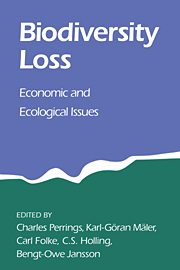Book contents
- Frontmatter
- Contents
- Foreword
- Preface
- List of contributors
- Introduction: framing the problem of biodiversity loss
- PART I CONCEPTUALISING DIVERSITY AND ECOSYSTEM FUNCTIONS
- PART II INTEGRATING ECOLOGY AND ECONOMICS IN THE ANALYSIS OF BIODIVERSITY LOSS
- PART III ECONOMIC ISSUES
- PART IV CONCLUSIONS
- 11 Unanswered questions
- References
- Index
11 - Unanswered questions
Published online by Cambridge University Press: 05 June 2012
- Frontmatter
- Contents
- Foreword
- Preface
- List of contributors
- Introduction: framing the problem of biodiversity loss
- PART I CONCEPTUALISING DIVERSITY AND ECOSYSTEM FUNCTIONS
- PART II INTEGRATING ECOLOGY AND ECONOMICS IN THE ANALYSIS OF BIODIVERSITY LOSS
- PART III ECONOMIC ISSUES
- PART IV CONCLUSIONS
- 11 Unanswered questions
- References
- Index
Summary
Biodiversity preservation versus biodiversity conservation
The contributors to this volume have argued that the fundamental goal of biodiversity conservation is not species preservation for its own sake, but the protection of the productive potential of those ecosystems on which human activity depends. This, it has been argued, is a function of the resilience of such ecosystems. Ecosystem resilience has been shown to be a measure of the limits of the local stability of the self-organisation of the system. Hence a system may be said to be resilient with respect to exogenous stress or shocks of a given magnitude if it is able to respond without losing self-organisation. Where species or population deletion jeopardises the resilience of an ecosystem providing essential services, then protection of ecosystem resilience implies species preservation. This is not to say that we should dismiss arguments for species preservation for its own sake. The identification of existence or nonuse value in contingent valuation exercises indicates that people do think in such terms. But it does make it clear that there is both an economically and ecologically sound rationale for ensuring the conservation of species that are not currently in use. More particularly, species which are not now keystone species but may become keystone species under different environmental conditions have insurance value, and this insurance value depends on their contribution to ecosystem resilience.
It is worth underlining the point that where the objective is the maintenance of ecosystem resilience, the appropriate measure of diversity is not genetic distance but what may be termed functional distance.
- Type
- Chapter
- Information
- Biodiversity LossEconomic and Ecological Issues, pp. 301 - 308Publisher: Cambridge University PressPrint publication year: 1995
- 8
- Cited by

